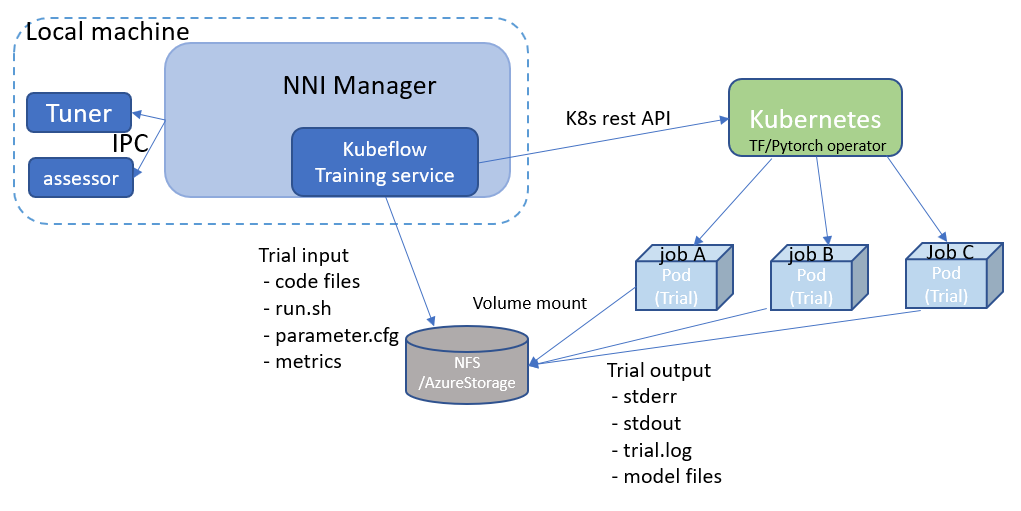Kubeflow Training Service¶
Now NNI supports running experiment on Kubeflow, called kubeflow mode. Before starting to use NNI kubeflow mode, you should have a Kubernetes cluster, either on-premises or Azure Kubernetes Service(AKS), a Ubuntu machine on which kubeconfig is setup to connect to your Kubernetes cluster. If you are not familiar with Kubernetes, here is a good start. In kubeflow mode, your trial program will run as Kubeflow job in Kubernetes cluster.
Prerequisite for on-premises Kubernetes Service¶
A Kubernetes cluster using Kubernetes 1.8 or later. Follow this guideline to set up Kubernetes.
Download, set up, and deploy Kubeflow to your Kubernetes cluster. Follow this guideline to setup Kubeflow.
Prepare a kubeconfig file, which will be used by NNI to interact with your Kubernetes API server. By default, NNI manager will use
~/.kube/configas kubeconfig file’s path. You can also specify other kubeconfig files by setting the KUBECONFIG environment variable. Refer this guideline to learn more about kubeconfig.If your NNI trial job needs GPU resource, you should follow this guideline to configure Nvidia device plugin for Kubernetes.
Prepare a NFS server and export a general purpose mount (we recommend to map your NFS server path in
root_squash option, otherwise permission issue may raise when NNI copy files to NFS. Refer this page to learn what root_squash option is), or Azure File Storage.Install NFS client on the machine where you install NNI and run nnictl to create experiment. Run this command to install NFSv4 client:
apt install nfs-common
Install NNI:
python -m pip install nni
Prerequisite for Azure Kubernetes Service¶
NNI support Kubeflow based on Azure Kubernetes Service, follow the guideline to set up Azure Kubernetes Service.
Install Azure CLI and kubectl. Use
az loginto set azure account, and connect kubectl client to AKS, refer this guideline.Deploy Kubeflow on Azure Kubernetes Service, follow the guideline.
Follow the guideline to create azure file storage account. If you use Azure Kubernetes Service, NNI need Azure Storage Service to store code files and the output files.
To access Azure storage service, NNI need the access key of the storage account, and NNI use Azure Key Vault Service to protect your private key. Set up Azure Key Vault Service, add a secret to Key Vault to store the access key of Azure storage account. Follow this guideline to store the access key.
Design¶

Kubeflow training service instantiates a Kubernetes rest client to interact with your K8s cluster’s API server.
For each trial, we will upload all the files in your local trial_code_directory
together with NNI generated files like parameter.cfg into a storage volumn.
Right now we support two kinds of storage volumes:
nfs
and azure file storage,
you should configure the storage volumn in experiment config.
After files are prepared, Kubeflow training service will call K8S rest API to create Kubeflow jobs
(tf-operator job
or pytorch-operator job)
in K8S, and mount your storage volume into the job’s pod.
Output files of Kubeflow job, like stdout, stderr, trial.log or model files, will also be copied back to the storage volumn.
NNI will show the storage volumn’s URL for each trial in web portal, to allow user browse the log files and job’s output files.
Supported operator¶
NNI only support tf-operator and pytorch-operator of Kubeflow, other operators are not tested. Users can set operator type in experiment config. The setting of tf-operator:
config.training_service.operator = 'tf-operator'
The setting of pytorch-operator:
config.training_service.operator = 'pytorch-operator'
If users want to use tf-operator, he could set ps and worker in trial config.
If users want to use pytorch-operator, he could set master and worker in trial config.
Supported storage type¶
NNI support NFS and Azure Storage to store the code and output files, users could set storage type in config file and set the corresponding config.
The setting for NFS storage are as follows:
config.training_service.storage = K8sNfsConfig(
server = '10.20.30.40', # your NFS server IP
path = '/mnt/nfs/nni' # your NFS server export path
)
If you use Azure storage, you should set storage in your config as follows:
config.training_service.storage = K8sAzureStorageConfig(
azure_account = your_azure_account_name,
azure_share = your_azure_share_name,
key_vault_name = your_vault_name,
key_vault_key = your_secret_name
)
Run an experiment¶
Use PyTorch quickstart as an example. This is a PyTorch job, and use pytorch-operator of Kubeflow. The experiment config is like:
from nni.experiment import Experiment, K8sNfsConfig, KubeflowRowConfig
experiment = Experiment('kubeflow')
experiment.config.search_space = search_space
experiment.config.tuner.name = 'TPE'
experiment.config.tuner.class_args['optimize_mode'] = 'maximize'
experiment.config.max_trial_number = 10
experiment.config.trial_concurrency = 2
experiment.config.operator = 'pytorch-operator'
experiment.config.api_version = 'v1alpha2'
experiment.config.training_service.storage = K8sNfsConfig()
experiment.config.training_service.storage.server = '10.20.30.40'
experiment.config.training_service.storage.path = '/mnt/nfs/nni'
experiment.config.training_service.worker = KubeflowRowConfig()
experiment.config.training_service.worker.replicas = 2
experiment.config.training_service.worker.command = 'python3 model.py'
experiment.config.training_service.worker.gpuNumber = 1
experiment.config.training_service.worker.cpuNumber = 1
experiment.config.training_service.worker.memorySize = '4g'
experiment.config.training_service.worker.code_directory = '.'
experiment.config.training_service.master = KubeflowRowConfig()
experiment.config.training_service.master.replicas = 1
experiment.config.training_service.master.command = 'python3 model.py'
experiment.config.training_service.master.gpuNumber = 0
experiment.config.training_service.master.cpuNumber = 1
experiment.config.training_service.master.memorySize = '4g'
experiment.config.training_service.master.code_directory = '.'
experiment.config.training_service.worker.docker_image = 'msranni/nni:latest' # default
Once it’s ready, run:
experiment.run(8080)
NNI will create Kubeflow pytorchjob for each trial,
and the job name format is something like nni_exp_{experiment_id}_trial_{trial_id}.
You can see the Kubeflow jobs created by NNI in your Kubernetes dashboard.
Notice: In kubeflow mode, NNIManager will start a rest server and listen on a port which is your NNI web portal’s port plus 1.
For example, if your web portal port is 8080, the rest server will listen on 8081,
to receive metrics from trial job running in Kubernetes.
So you should enable 8081 TCP port in your firewall rule to allow incoming traffic.
Once a trial job is completed, you can go to NNI web portal’s overview page (like http://localhost:8080/oview) to check trials’ information.